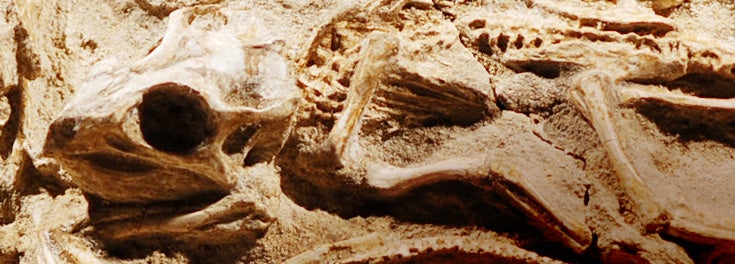 If you’ve always been captivated by dinosaurs, then you may want to have a chat with David Fastovsky. The URI geosciences professor is so widely known for his research on the extinction of the dinosaurs that his wax likeness lives immortally in the Milwaukee Public Museum as part of a diorama explaining the clay layer of Earth that marks the boundary between two geological periods.
If you’ve always been captivated by dinosaurs, then you may want to have a chat with David Fastovsky. The URI geosciences professor is so widely known for his research on the extinction of the dinosaurs that his wax likeness lives immortally in the Milwaukee Public Museum as part of a diorama explaining the clay layer of Earth that marks the boundary between two geological periods.
Even if your idea of Earth science has nothing to do with fossils, URI can still rock your world.
Professor Fastovsky is quoted in the news almost every time a new dinosaur discovery is made, and he’s practically famous for his 2011 description of a 70-million-year-old nest containing the fossilized remains of 15 baby Protoceratops andrewsi dinosaurs in Mongolia. It was the first nest of its kind ever found and the first evidence that Protoceratops juveniles stayed in the nest for an extended period.
But not everyone who studies the geosciences at URI wants to follow in Professor Fastovsky’s dinosaur-hunting footsteps. Take Marie Jimenez, for example, who just graduated in May. She’s fascinated by fossils and wants to be a paleontologist, but that doesn’t means she plans to study dinosaurs. “Paleontology is all about uncovering the history of the Earth, whether by dinosaur fossils or other types of fossils,” she explained. “You have to know a little about everything to attack a problem. It’s sort of like being a geology detective.”
That’s exactly the role she played last summer as an intern at Dinosaur National Monument in Utah, which she describes as “a vertical dinosaur quarry” where the fossil beds are tilted at a 67-degree angle. “So instead of looking down into the ground at the fossils, you’re seeing this 150-foot wall of bones in front of you,” Marie said.
Just about every day for 11 weeks she sorted through archival documents, photographs, and maps from the early days of the 100-year-old fossil quarry to unearth hidden specimens and historical details to help make the work of paleontologists a little easier. Her work is now part of the National Park Service’s digital quarry.
Even if your idea of Earth science has nothing whatsoever to do with fossils, URI can still rock your world. You can study with leading experts on underwater volcanoes, award-winning faculty studying earthquakes and the evolution of the Earth, the developer of a seismic model to monitor nuclear explosions in the Middle East, a professor studying the evolution of the earliest life on Earth, an expert on global sea level rise, or several hydrologists working to find clean drinking water for developing nations like India, Nepal and Indonesia.
Which is why the geosciences may be the only academic discipline at URI where it’s fun to be between a rock and a hard place.
